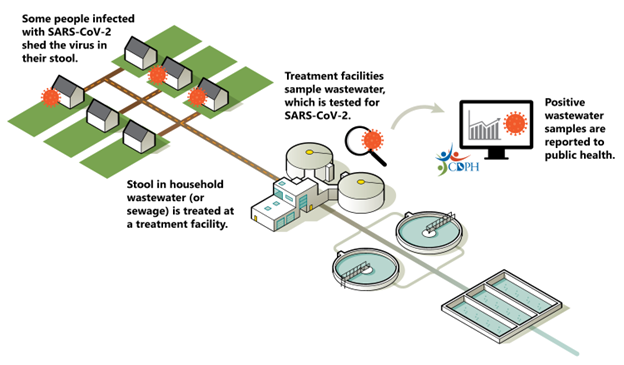Wastewater Monitoring
Testing sewage for viruses, bacteria, toxins, or other substances
What is wastewater monitoring?
Wastewater monitoring (WWM) is the testing of sewage for viruses, bacteria, toxins, or other substances that can be shed into wastewater via toilets, sinks, showers, laundry, and drains.
Through funding provided by the CDC’s National Wastewater Surveillance System (NWSS), the Alaska Division of Public Health is developing WWM infrastructure in many Alaska communities.
The following figure provides a basic overview of how WWM occurs in communities:

Why do we monitor wastewater?
WWM is a cost-effective and efficient tool for public health officials to monitor disease trends at the population level, in close to real time. It also captures disease information about people in the community who either do not have access to healthcare or are not seeking healthcare.
It can also be used to pinpoint specific areas or communities with higher potential of being or becoming hotspots for disease transmission; assess effectiveness of interventions; monitor emerging threats; and complement other public health disease monitoring tools.
Where is Alaska wastewater being tested?
Currently, most of Alaska wastewater testing is occurring through one of two national programs, CDC NWSS and WastewaterSCAN (both are conducted at Verily Labs, a subsidiary of Alphabet, Inc.). NWSS is a federal collaborative effort involving Verily Inc. and government agencies to establish a nationwide surveillance network for monitoring infectious diseases in wastewater. WastewaterSCAN is a private company specializing in wastewater monitoring technology that offers a broader scope of testing options than NWSS.
Testing in Bethel is occurring through the Yukon-Kuskokwim Health Corporation's Office of Environmental Health.
In the near future, additional testing will occur at two primary testing locations: the University of Alaska Anchorage’s AIMS Core Facility and the Department of Environmental Conservation’s Environmental Health Laboratory.
Capacity to conduct whole genome sequencing for wastewater samples is currently being developed through partnerships formed with CDC’s Arctic Investigations Program, the University of Alaska Fairbanks, and the Alaska State Public Health Laboratories.